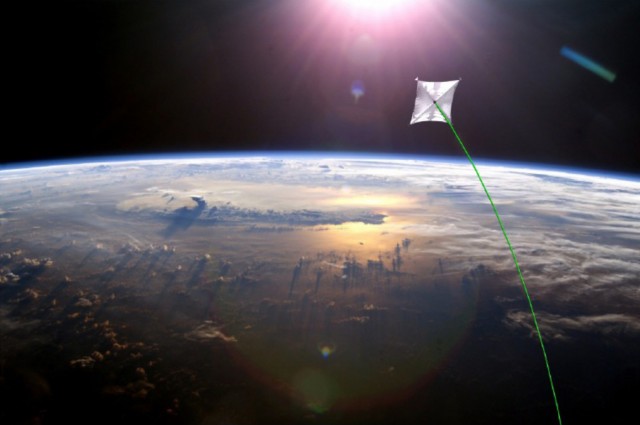Yes, you read that right. As quick as 30 minutes, by one estimate. The idea was explored by a scientist working on NASA’s Innovative Advanced Concepts (NIAC) program. Philip Lubin, from the University of California at Santa Barbara’s Experimental Cosmology Group, explained the idea last year. It was picked up again for a video on the NASA 360 channel, titled Going Interstellar.
“We could propel a 100-kilogram (220-pound) robotic craft to Mars in a few days,” Lubin said in the video, before going on to suggest other destinations we could visit. “Within about 25 light-years of the Earth there’s actually quite a few potential exoplanets and habitable things to visit – that may be habitable, we don’t know of course. So there are many targets to choose from. The closest is Alpha Centauri, which is about four light-years away.”
In a paper titled A Roadmap to Interstellar Flight, submitted to the Journal of the British Interplanetary Society (JBIS) in April 2015, Lubin explained the idea further. He described how you could use a wafer-thin spacecraft with a meter-sized (3.2-foot) laser sail, which he calls DE-STAR (Directed Energy System for Targeting of Asteroids and ExplorRation). A powerful laser in Earth orbit, in the tens of gigawatts, would then be targeted at the sail, to accelerate it in the frictionless vacuum of space.
“As an example, on the eventual upper end, a full scale DE-STAR 4 (50-70 GW) will propel a wafer scale spacecraft with a one meter laser sail to about 26 percent the speed of light in about 10 minutes, reach Mars (1 AU [astronomical unit, the Earth-Sun distance]) in 30 minutes, pass Voyager 1 in less than 3 days, pass 1,000 AU in 12 days and reach Alpha Centauri in about 15 years,” Lubin wrote.
What’s more, he says that this technology is available right now. Whereas things like warp drivesremain a fantasy, direct energy propulsion is achievable with current technologies, and it is scalable, meaning larger craft could also make use of it.
“This technology is NOT science fiction. Things have changed,” said Lubin.
Sadly, there are currently no firm projects in the works, aside from a few proposals. But the idea is hugely exciting nonetheless. While admittedly you couldn’t attach much to a wafer-thin spacecraft, one could feasibly contain basic instrumentation and send back small amounts of data to Earth. There would also be no way for the spacecraft to stop without an equivalent laser at the other end, but that wouldn’t be a problem, considering this would just essentially be a scouting flyby spacecraft.
Imagine we could send such a tiny, manmade spacecraft to Alpha Centauri, our nearest star system at 4 light-years away, in less than two decades, a similar amount of time it took New Horizons to reach Pluto, and return useful data to Earth? It’s an incredible concept, and one that is surely worth looking into at the very least.
Photo credit: An illustration of how laser propulsion could work. NASA
“We could propel a 100-kilogram (220-pound) robotic craft to Mars in a few days,” Lubin said in the video, before going on to suggest other destinations we could visit. “Within about 25 light-years of the Earth there’s actually quite a few potential exoplanets and habitable things to visit – that may be habitable, we don’t know of course. So there are many targets to choose from. The closest is Alpha Centauri, which is about four light-years away.”
In a paper titled A Roadmap to Interstellar Flight, submitted to the Journal of the British Interplanetary Society (JBIS) in April 2015, Lubin explained the idea further. He described how you could use a wafer-thin spacecraft with a meter-sized (3.2-foot) laser sail, which he calls DE-STAR (Directed Energy System for Targeting of Asteroids and ExplorRation). A powerful laser in Earth orbit, in the tens of gigawatts, would then be targeted at the sail, to accelerate it in the frictionless vacuum of space.
“As an example, on the eventual upper end, a full scale DE-STAR 4 (50-70 GW) will propel a wafer scale spacecraft with a one meter laser sail to about 26 percent the speed of light in about 10 minutes, reach Mars (1 AU [astronomical unit, the Earth-Sun distance]) in 30 minutes, pass Voyager 1 in less than 3 days, pass 1,000 AU in 12 days and reach Alpha Centauri in about 15 years,” Lubin wrote.
What’s more, he says that this technology is available right now. Whereas things like warp drivesremain a fantasy, direct energy propulsion is achievable with current technologies, and it is scalable, meaning larger craft could also make use of it.
“This technology is NOT science fiction. Things have changed,” said Lubin.
Sadly, there are currently no firm projects in the works, aside from a few proposals. But the idea is hugely exciting nonetheless. While admittedly you couldn’t attach much to a wafer-thin spacecraft, one could feasibly contain basic instrumentation and send back small amounts of data to Earth. There would also be no way for the spacecraft to stop without an equivalent laser at the other end, but that wouldn’t be a problem, considering this would just essentially be a scouting flyby spacecraft.
Imagine we could send such a tiny, manmade spacecraft to Alpha Centauri, our nearest star system at 4 light-years away, in less than two decades, a similar amount of time it took New Horizons to reach Pluto, and return useful data to Earth? It’s an incredible concept, and one that is surely worth looking into at the very least.
 New topic
New topic Printable
Printable
 Report post to moderator
Report post to moderator